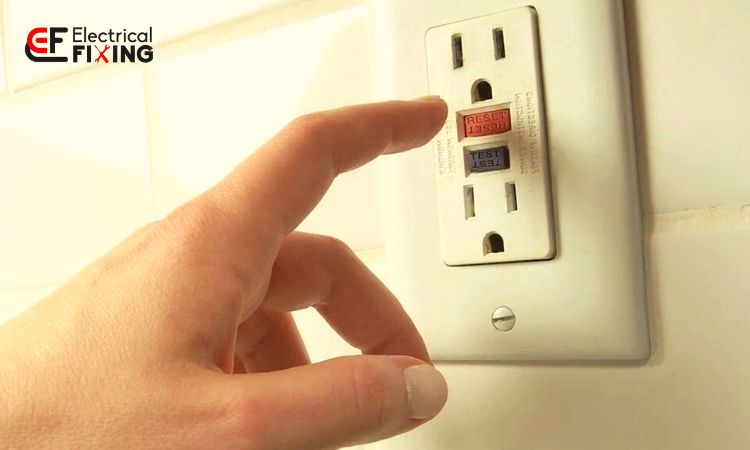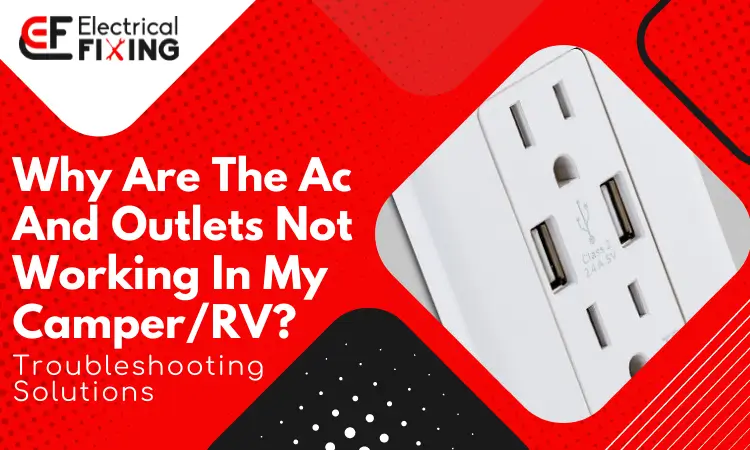Hey there! This post contains affiliate links to products. We may receive a commission for purchases made through these links. But it never influences our product selection process.
If you’ve been experiencing a problem with your GFCI outlet constantly tripping without load, it can be frustrating and even dangerous. A GFCI outlet is a type of electrical receptacle that provides protection against electrical shocks by interrupting the flow of electricity when it detects a ground fault. While it’s normal for a GFCI outlet to trip occasionally, especially when there’s a fault in the circuit, it’s not normal for it to trip repeatedly without any apparent load.
That there could be several reasons for a GFCI outlet to keep tripping even when there is no load connected to it. It could be due to a faulty GFCI outlet, a ground fault in the circuit, a wiring issue, a defective appliance or device, moisture, or even a faulty breaker.
Troubleshooting steps include inspecting the outlet and wiring for any visible damage, testing the outlet using the test and reset buttons, and checking for any defective devices or appliances that may be causing the issue. If the problem persists, it’s best to consult a professional electrician for further assistance.
In this article, we’ll explore the causes of this issue and provide some tips on how to fix it.
What is a GFCI Outlet and How Does it Work?
Before we delve into the causes of a GFCI outlet tripping without load, let’s first understand what a GFCI outlet is and how it works. A GFCI outlet is designed to protect people from electrical shocks caused by ground faults. A ground fault occurs when the current from the hot wire comes into contact with a grounded surface, such as a metal appliance or a person. This can happen when a circuit is damaged or when there’s a short circuit.
A GFCI outlet monitors the amount of current flowing between the hot and neutral wires. If it detects a difference of more than 5 milliamps, it will quickly interrupt the flow of electricity, thereby protecting people from electrical shocks. GFCI outlets are commonly used in areas where electrical appliances are used near water, such as in bathrooms, kitchens, and outdoor areas.
Why Does a GFCI Outlet Keep Tripping Without Load?

If your GFCI outlet keeps tripping without load, there are several possible reasons for this issue. Let’s take a look at some of the most common causes:
Faulty GFCI Outlet
One of the most common causes of a GFCI outlet tripping without load is a faulty outlet. Over time, GFCI outlets can wear out or become damaged, leading to false tripping. If you suspect that your GFCI outlet is faulty, you can try resetting it by pressing the “test” button and then the “reset” button. If the outlet still trips without any load, it’s likely that the outlet needs to be replaced.
Ground Fault
Another possible cause of a GFCI outlet tripping without load is a ground fault in the circuit. A ground fault can occur when the hot wire comes into contact with a grounded surface, such as a metal appliance or a person. This can happen when a circuit is damaged or when there’s a short circuit. If you suspect that there’s a ground fault in the circuit, you should call a licensed electrician to diagnose and fix the issue.
Moisture
Moisture is another common cause of a GFCI outlet tripping without load. When water comes into contact with an electrical circuit, it can create a ground fault and cause the GFCI outlet to trip. If you have a GFCI outlet in a bathroom, for example, it’s important to make sure that the outlet and its surrounding areas are kept dry.
Overloading
Overloading is another possible cause of a GFCI outlet tripping without load. If you have too many appliances or devices plugged into the same outlet or circuit, it can overload the circuit and cause the GFCI outlet to trip. To prevent overloading, you should avoid plugging too many devices into the same outlet or circuit.
How to Fix a GFCI Outlet Keeps Tripping Without Load
If your GFCI outlet keeps tripping without load, there are several things that you can do to fix the issue. Here are some tips:
Check Other Outlets
If you have multiple GFCI outlets in your home, it’s possible that the issue is not with the outlet that keeps tripping, but with another outlet in the same circuit. You can try resetting all of the GFCI outlets in your home and see if that resolves the issue.
Inspect the Wiring
If you suspect that the issue is with the wiring, you should call a licensed electrician to inspect the wiring and diagnose the problem. Attempting to fix wiring issues on your own can be dangerous and should only be done by a trained professional.
Replace the Outlet
If the GFCI outlet is faulty and resetting it doesn’t solve the problem, you may need to replace the outlet. Make sure to turn off the power to the outlet before attempting to replace it, and follow proper safety precautions.
Reduce the Load
If overloading is the issue, you can reduce the load on the circuit by unplugging some of the appliances or devices that are connected to the same outlet or circuit. You can also consider adding more outlets to the circuit to distribute the load.
Keep the Outlet Dry
If moisture is the issue, you can prevent the outlet from tripping by keeping it and its surrounding areas dry. Make sure to use waterproof covers for any electrical appliances in areas where water is present.
GFCI Outlet Keeps Tripping After Reset
If your GFCI outlet keeps tripping after you have reset it, there are several possible reasons why this could be happening. Some of the most common reasons include:
Overloading the Circuit
One of the most common reasons why a GFCI outlet may keep tripping is because the circuit is overloaded. This can happen if you have too many appliances or devices plugged into the same outlet or circuit. To resolve this issue, try unplugging some of the appliances or devices and see if the GFCI outlet stops tripping.
Faulty GFCI Outlet
Another reason why a GFCI outlet may keep tripping after being reset is that the outlet itself is faulty. Over time, GFCI outlets can wear out and become less effective. If this is the case, you may need to replace the outlet with a new one.
Moisture or Water Damage
GFCI outlets are designed to protect against electrical shocks in wet or damp areas. If the outlet is exposed to moisture or water damage, it can trip repeatedly, even after being reset. To prevent this from happening, keep the outlet and the surrounding area dry.
Wiring Issues
Wiring issues can also cause GFCI outlets to trip repeatedly. If the wiring is damaged, loose, or outdated, it can cause electrical shorts or other issues that can trigger the GFCI outlet. This is a serious issue that should be addressed by a licensed electrician.
Other Electrical Issues
There are several other electrical issues that can cause a GFCI outlet to trip repeatedly. For example, if there is a ground fault in the wiring or if there is a problem with the electrical system itself, the GFCI outlet may trip. If you are unable to identify the source of the problem, it’s important to call a licensed electrician to diagnose and fix the issue.
What to Do if Your GFCI Outlet Keeps Tripping After Reset
If your GFCI outlet keeps tripping after you have reset it, there are several steps you can take to address the issue. Here are some tips to help you troubleshoot the problem:
- Unplug any appliances or devices that are connected to the GFCI outlet. If the outlet stops tripping, the problem may be due to an overloaded circuit.
- Check the outlet for signs of moisture or water damage. If you notice any signs of water damage, such as rust or discoloration, you may need to replace the outlet.
- If the outlet is not visibly damaged, try resetting it again. If it continues to trip, you may need to replace the outlet with a new one.
- If none of these steps resolve the issue, call a licensed electrician to inspect the wiring and diagnose the problem. Attempting to fix wiring issues on your own can be dangerous and should only be done by a trained professional.
Frequently Asked Questions (FAQs):
Why does my GFCI outlet keep tripping even when there’s no load connected?
There could be several reasons for this issue. It’s possible that there is a ground fault in the circuit, a defective GFCI outlet, or a wiring problem. It’s also worth checking if there are any moisture-related issues, such as water getting into the outlet.
How can I determine if the GFCI outlet is defective?
To check if the GFCI outlet is the problem, you can try replacing it with a new one. If the new outlet doesn’t trip, then the old outlet was likely defective. However, if the new outlet also trips, the issue might be with the wiring or another component in the circuit.
What steps can I take to troubleshoot wiring issues?
Start by checking the wiring connections at the GFCI outlet and any other outlets connected in the same circuit. Look for loose or damaged wires and ensure they are properly connected. It’s recommended to turn off the power before inspecting or working on the wiring.
Is it possible for a neighboring GFCI outlet to cause the tripping issue?
Yes, if multiple outlets are connected to the same GFCI circuit, a fault in any of them can cause the GFCI to trip. Check all the outlets connected to the same circuit and ensure they are functioning properly. Resetting all the GFCI outlets in the circuit may help identify and resolve the problem.
Conclusion
A GFCI outlet that keeps tripping without load can be a frustrating and potentially dangerous issue. Understanding the causes of the issue and taking proper safety precautions can help you diagnose and fix the problem. If you’re not comfortable with electrical work, it’s important to call a licensed electrician to diagnose and fix any issues with your electrical system. By taking proper precautions and staying vigilant, you can ensure the safety of yourself and your loved ones.
Hey, I’m Steven Jones, the founder, and writer of this site. I have worked in Electrical for the past 5 years. I also know how to save energy and how to troubleshoot our electrical devices. I hope you enjoy my blog.



